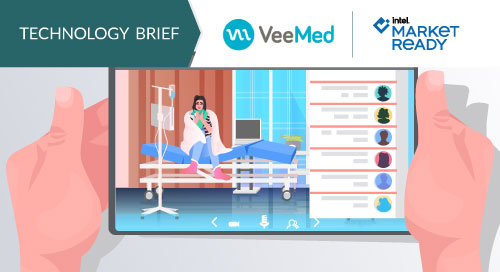Health Tech Transforms Virtual Care

Not all heroes wear capes—but a lot of them wear scrubs. When we consider those who are operating on the frontlines during the pandemic, healthcare professionals top the list. Despite the scarcity of adequate personal protective equipment (PPE) and the highly contagious nature of the COVID-19 virus, they have worked tirelessly.
At Banner Health, that dangerous situation was alleviated through an ingenious health tech solution that allowed clinicians to use virtual care technology to safely monitor patients without entering their hospital rooms. Using sophisticated healthcare technology, they were able to transform existing in-room televisions into virtual care endpoints in 28 of its acute-care hospitals and emergency rooms.
Thanks to a spirit of collaboration, the hospital network was able to quickly roll out a low-cost solution to ensure healthcare staff could work more safely and effectively. VeeMed Inc., a provider of next-gen turnkey telemedicine solutions, had already been working with Banner Health on another healthcare technology implementation. But as the pandemic persisted, leadership requested a directional shift.
“They essentially said, ‘We need to change our implementation plan for your platform because now we need a solution for our COVID-19 patients,’” recounts Ed Leer, VeeMed’s senior vice president of business development.
Within a mere two months, the company’s Virtual Care Delivery Platform—based on its VeeKast software—had been developed and deployed. “As a software company, we could easily pivot to meet the challenge because we didn’t have to develop new products or hardware; we just had to reconfigure and utilize what was out there,” Leer explains.
VeeKast is elegant in its simplicity, both inexpensive and easy to implement. By plugging a micro PC, like the Intel® NUC, into the back of the patient’s in-room TV, it is transformed into a telehealth-ready patient room option.
Now, remote visits save Banner personnel time and money as providers can keep a watchful eye on patients, have virtual consults, and even bring other caregivers and family members into the session, without having to don gowns or use the limited supply of PPE.
Getting buy-in from Banner Health’s IT department was easy because they immediately saw the value and implementation is a snap. As long as the room has a plug and the TV has High-Definition Media Input (HDMI) capability, the ability to provide quality care using advanced software and camera systems is ready to go.
That allowed Banner to roll out VeeKast on a tight timeframe, and today over 1,200 devices are in use across the network. “Because it was so simple to implement, they could install literally hundreds of units a week, which made it even more valuable, given that timing was so critical in addressing this vital need,” Leer says.
Plugging a micro PC into the back of a patient’s in-room TV, transforms it into a telehealth-ready patient room option.
Health Tech Extends Beyond COVID-19
While VeeMed modified its software specifically to provide an answer to a COVID-19-related challenge, the VeeKast solution has multiple applications to bolster patient care in many other settings.
Anywhere you have a TV, or display, in any kind of clinical operation, you can now have a telehealth endpoint,” Leer points out. So while VeeKast removed the barrier of gowning and PPE to aid with COVID-19 patients, this healthcare technology can provide efficiency in many other use cases. For example, it can minimize the time it takes hospitalists to round rooms in a large hospital as they can use the platform to visit patients virtually, including those in distant facilities.
VeeMed is currently beginning to deploy VeeKast as part of its TeleICU, TelePsych, and TeleStroke programs, which are SaaS products offered by the company that allow a healthcare facility to contact an on-call physician to assist with a case.
With an ICU or stroke emergency, a high-quality camera is essential to give the specialist a closer look. “With our platform, the neurologist can remotely control the camera to zoom into the pupils in a stroke case, for example, which leads to a better diagnosis,” Leer explains.
This virtual care capability means a rural hospital could avoid having to transfer patients to another facility, putting the patient at risk. And from a financial perspective, it means the hospital can retain that patient revenue.
“Our solution is deployed in critical care settings across the country, affording quality care to thousands of patients every day. We’re starting to see hospitals open their minds and realize they can do something completely differently than they’d ever thought of before,” says Leer.
Virtual-Care Adoption on the Rise
Just as COVID-19 has created revolutionary change in every field, it will usher in a new demand for telehealth. The current environment has knocked down barriers and shown its value to physicians, patients, and payors, whereas it previously was not a high priority for any of those groups, Leer says.
Leer predicts consumers and physicians alike will embrace telehealth’s ability to not only provide remote diagnoses but also to offer continuous monitoring to track patients and their progress.
“COVID-19 has been the catalyst for dramatic change, and at VeeMed,” Leer says. “We have tremendous ideas for what can be done, not only in the visual and audio aspects of care, but around analytics, AI, and machine learning. These innovations will allow the healthcare community to do an even more effective job, which will ultimately improve patient well-being.”